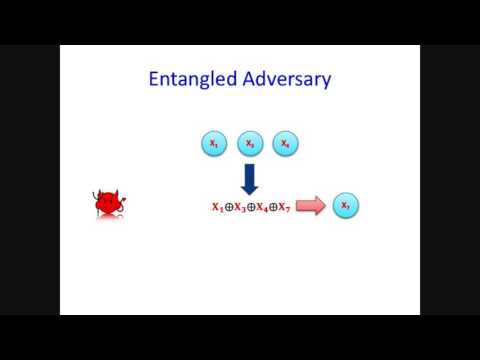Welcome to the resource topic for 2016/100
Title:
On the Complexity of Scrypt and Proofs of Space in the Parallel Random Oracle Model
Authors: Joël Alwen, Binyi Chen, Chethan Kamath, Vladimir Kolmogorov, Krzysztof Pietrzak, Stefano Tessaro
Abstract:We investigate lower bounds in terms of time and memory on the {\em parallel} complexity of an adversary \cal A computing labels of randomly selected challenge nodes in direct acyclic graphs, where the w-bit label of a node is the hash H(.) (modelled as a random oracle with w-bit output) of the labels of its parents. Specific instances of this general problem underlie both proofs-of-space protocols [Dziembowski et al. CRYPTO’15] as well as memory-hardness proofs including {\sf scrypt}, a widely deployed password hashing and key-derivation function which is e.g. used within Proofs-of-Work for digital currencies like Litecoin. Current lower bound proofs for these problems only consider {\em restricted} algorithms \cal A which perform only a single H(.) query at a time and which only store individual labels (but not arbitrary functions thereof). This paper substantially improves this state of affairs; Our first set of results shows that even when allowing multiple parallel \hash queries, the cumulative memory complexity'' (CMC), as recently considered by Alwen and Serbinenko [STOC '15], of ${\sf scrypt}$ is at least $w \cdot (n/\log(n))^2$, when ${\sf scrypt}$ invokes $H(.)$ $n$ times. Our lower bound holds for adversaries which can store (1) Arbitrary labels (i.e., random oracle outputs) and (2) Certain natural functions of these labels, e.g., linear combinations. The exact power of such adversaries is captured via the combinatorial abstraction of parallel entangled’’ pebbling games on graphs, which we introduce and study. We introduce a combinatorial quantity \gamma_n and under the conjecture that it is upper bounded by some constant, we show that the above lower bound on the CMC also holds for arbitrary algorithms \cal A, storing in particular arbitrary functions of their labels. We also show that under the same conjecture, the {\em time complexity} of computing the label of a random node in a graph on n nodes (given an initial kw-bit state) reduces tightly to the time complexity for entangled pebbling on the same graph (given an initial k-node pebbling). Under the conjecture, this solves the main open problem from the work of Dziembowski et al. In fact, we note that every non-trivial upper bound on \gamma_n will lead to the first non-trivial bounds for general adversaries for this problem.
ePrint: https://eprint.iacr.org/2016/100
Talk: https://www.youtube.com/watch?v=arorRu-3eog
See all topics related to this paper.
Feel free to post resources that are related to this paper below.
Example resources include: implementations, explanation materials, talks, slides, links to previous discussions on other websites.
For more information, see the rules for Resource Topics .
